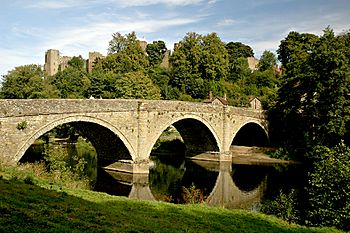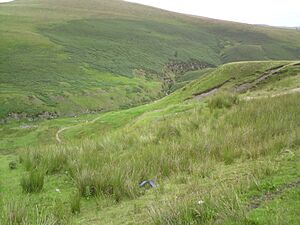River Teme facts for kids
Quick facts for kids River Teme |
|
|---|---|

The River Teme at Ludlow, Shropshire
|
|
| Other name(s) | Welsh: Afon Tefeidiad |
| Country | Wales, England |
| Counties | Powys, Shropshire, Herefordshire, Worcestershire |
| Physical characteristics | |
| Main source | Dolfor Kerry Hills, Radnorshire, Powys, Wales 506 m (1,660 ft) 52°28′18″N 3°19′28″W / 52.47167°N 3.32444°W |
| River mouth | Confluence with River Severn Powick, Worcestershire, England 14 m (46 ft) 52°09′48″N 2°14′44″W / 52.16333°N 2.24556°W |
| Length | 130 km (81 mi) |
| Basin features | |
| Tributaries |
|
The River Teme (pronounced Afon Tefeidiad in Welsh) is a river in the United Kingdom. It starts in Mid Wales, south of Newtown, Powys. The river flows southeast, forming part of the border between England and Wales for many miles. It passes through Knighton before entering England fully near Bucknell.
From there, it continues east to Ludlow in Shropshire. It then flows north of Tenbury Wells on the Shropshire/Worcestershire border. Finally, it joins the River Severn south of Worcester. In 1996, the entire River Teme was named a SSSI by English Nature. This means it is a special place for nature.
Many old bridges cross the river. One at Tenbury Wells was rebuilt by Thomas Telford after a flood in 1795. The Elan aqueduct, which carries water, also crosses the Teme several times.
Contents
- What's in a Name? The River Teme's History
- Where the River Teme Flows: A Journey Through the Landscape
- River Features and Water Levels
- Tributaries: Rivers Joining the Teme
- Flooding and Drying Out
- Nature and Wildlife: Animals of the Teme
- Fun on the River: Recreational Activities
- River Teme in History: Old Boats and Trade
- Cultural Connections: The Teme in Poetry
- Towns and Villages Along the River Teme
- Images for kids
- See also
What's in a Name? The River Teme's History
The name "Teme" is very old. It is similar to other river names in England, like the River Thames and River Tamar. Experts believe these names come from the ancient Brythonic word Tamesa. This word might have meant 'the dark one'.
Where the River Teme Flows: A Journey Through the Landscape
The River Teme begins in Mid Wales. Its source is on the western side of Bryn Coch in the Kerry Hills, near Dolfor. Two other rivers, the River Ithon and the River Mule, also start very close by.
For several miles, the Teme flows along the border between England and Wales. It passes villages like Felindre, Beguildy, and Knucklas in Powys. On the Shropshire side, it passes Llanfair Waterdine. It then flows past the town of Knighton.
The river continues east, near Bucknell and Brampton Bryan. The River Clun joins it at Leintwardine in Herefordshire. The Teme then takes a winding path, flowing southeast and then northeast. It reaches Bromfield, where the River Onny joins it.
From Bromfield to the River Severn at Worcester, the Teme flows through Herefordshire, Shropshire, and Worcestershire. This part of the river is about 40 miles (65 km) long.
River Features and Water Levels
The upper parts of the river are usually steep. The water flows fast but is quite shallow. You can still see some old water mills and many weirs. There are several weirs near the historic town of Ludlow.
Below Tenbury Wells, the river becomes calmer but is still shallow. It has strong cross currents. The amount of water in the Teme changes a lot. This has become more noticeable recently because more water is taken out for farming.
The river flows over different types of rock, including shales and Devonian sandstones.
Tributaries: Rivers Joining the Teme
Several smaller rivers flow into the Teme:
- The River Corve joins the Teme just outside Ludlow.
- The Ledwyche Brook flows into the Teme at Burford. This is near where Herefordshire, Shropshire, and Worcestershire meet.
- The Kyre Brook joins the Teme at Tenbury Wells.
- The River Rea flows into the Teme at Newnham Bridge, Worcestershire.
The River Teme is the 16th longest river in the United Kingdom. It starts high up, about 450 meters (1,476 feet) above sea level. By the time it meets the River Severn, it is only about 14 meters (46 feet) above sea level.
Flooding and Drying Out
The Teme has often flooded in recent times. In June and July 2007, there were serious floods in places like Leintwardine and Tenbury Wells. Ludlow also flooded, but that was mainly from a smaller river called the River Corve.
However, the upper parts of the river can also dry out. The Environment Agency has noted this happens about every three years.
Nature and Wildlife: Animals of the Teme
The River Teme is a clean river. After many years of decline, the number of otters is now growing. However, things that block the river keep the number of salmon low.
Fun on the River: Recreational Activities
Fishing on the Teme
Fishing is a very popular activity on the River Teme. It is especially known for its barbel fishing.
Boating and Coracles
People have enjoyed boating on the Teme for a long time. You can still rent rowing boats at The Linney Park in Ludlow.
An annual coracle regatta (a race with small, round boats) is also held on the Teme. In 2005, it was at Leintwardine. In 2006, the 12th regatta was held at Mortimer's Cross.
A report from 2003 mentioned that there are no official agreements for canoeing on the Teme. However, some people do canoe, which can sometimes cause problems with landowners who want to protect fishing areas. Canoeing is more popular in the faster upper parts of the river when there is enough water.
River Teme in History: Old Boats and Trade
Boats Near Powick Mill
The last 1.5 miles (2.4 km) of the Teme, from Powick bridge to where it meets the River Severn, used to be navigable by boats. There was a coal wharf (a place for loading and unloading boats) near Powick Bridge. In the 1700s, pig iron was brought up the river to a forge (a type of factory) at Powick. In 1810, it was said that the Teme was "navigable for barges" for a short distance above Powick Bridge. However, the river's slope and shallow areas quickly stopped boats from going further.
Boats Further Upstream
There is not much clear proof that large barges traveled far up the Teme. Some people have claimed that boats used the Teme since Roman times. They say stone for a mill at Ashford Carbonel came from Caen in France in the 1300s by water. But there is no strong evidence to prove this.
William Sandys tried to make the Avon navigable in the 1600s. He was also allowed to improve the Teme between Worcester and Ludlow. But it seems he never did, perhaps because he used all his money on the Avon.
Ferries used to cross the river at places like Rochford and Clifton on Teme. A newspaper ad in 1750 said a miller at Stanford-on-Teme had a boat for sale that could carry 10 tons. But without locks, this boat could not have passed the weirs at mills.
Some old pictures, supposedly of Ludlow with boats on the river, might not be completely accurate. They might have been partly imagined by the artist.
Cultural Connections: The Teme in Poetry
The poet A.E. Housman wrote a poem that mentions the River Teme:
In valleys of springs of rivers
By Ony and Teme and Clun
The country for easy livers
The quietest under the sun
Towns and Villages Along the River Teme
- (source)
- Felindre
- Beguildy
- Llanfair Waterdine
- Knucklas
- Knighton, Powys
- Bucknell
- Brampton Bryan
- Leintwardine
- Burrington
- Bromfield
- Ludlow
- Ashford Bowdler
- Ashford Carbonel
- Little Hereford
- Tenbury Wells
- Knighton-on-Teme
- Lower Rochford
- Newnham Bridge
- Eastham
- Eardiston
- Stockton-on-Teme
- Stanford Bridge
- Shelsley Walsh
- Shelsley Beauchamp
- Clifton-upon-Teme
- Whitbourne
- Martley
- Knightwick
- Broadwas
- Lulsley
- Cotheridge
- Leigh
- Bransford
- Powick
- Worcester
Images for kids
See also
 In Spanish: Río Teme para niños
In Spanish: Río Teme para niños




